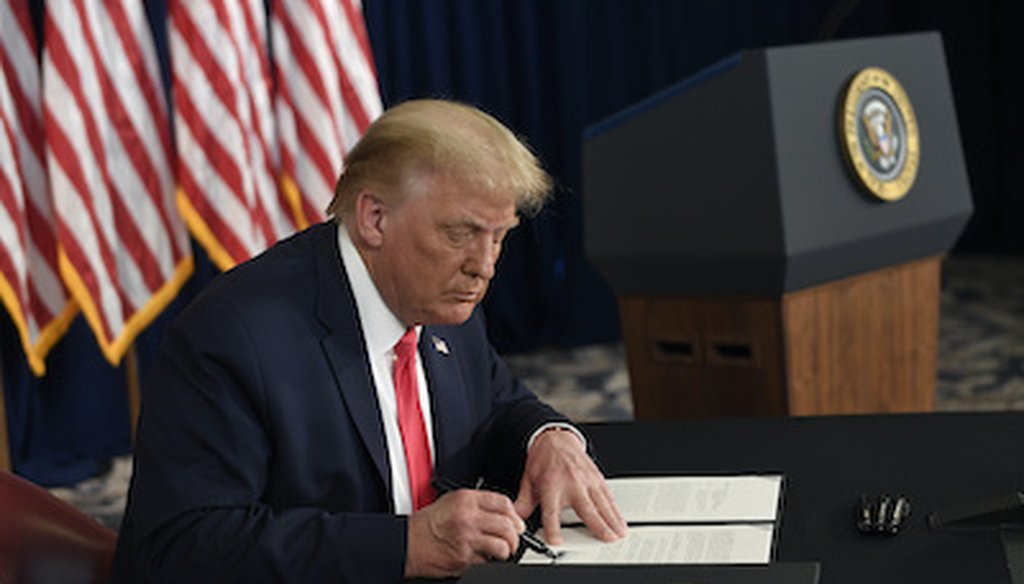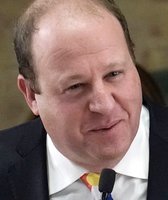Stand up for the facts!
Our only agenda is to publish the truth so you can be an informed participant in democracy.
We need your help.
I would like to contribute

President Donald Trump signs one of four executive measures addressing the economic fallout from the COVID-19 pandemic on Aug. 8, 2020. (AP)
If Your Time is short
-
If implemented, the measure would provide $400 a week in extra unemployment aid.
-
The plan requires states to pay 25%, or $100, for each person. Some governors have said that’s unlikely because many states continue to struggle financially.
-
The action will likely face legal challenges, experts say, and states would have to set up an entirely new program to distribute the money.
Amid gridlocked negotiations on a new coronavirus stimulus package, President Donald Trump is trying to partially extend more unemployment dollars to those out of work because of the pandemic.
Unemployed workers received a $600 weekly supplement starting in late March, but it expired July 31.
The measure Trump signed would provide a reduced weekly benefit of $400 on top of what people receive from their state unemployment program — if it is implemented as Trump wants. There are many complications.
Because the executive action circumvents Congress, which controls federal spending, it will likely face legal challenges. That would slow any disbursement of funds. Then there’s the complicated matter of implementing a 25% share with states who say they can’t pull it off with their already stressed budgets.
New York Governor Andrew Cuomo, a Democrat, said the measure was based on shaky legal ground and can’t replace legislative actions.
"States can’t pay 25% of unemployment costs," Cuomo wrote on Twitter. "It’s simply impossible."
The memorandum requires states to enter a financial agreement with the federal government and pick up 25% of the tab (or $100) for each person, a provision that was criticized by governors as many states continue to struggle financially because of the virus.
The federal portion of the money would come from the Department of Homeland Security’s Disaster Relief Fund, which is typically used for response and recovery efforts from major disasters and emergencies. The extra benefit would last until the fund is down to $25 billion, or Dec. 6, 2020, whichever comes first.
A day after signing the measure, Trump suggested it may be possible for the federal government to pay the full cost, if governors make a request.
"We have a system where we can do 100% or we can do 75%, they pay 25(%), and it will depend on the state," Trump told reporters at his New Jersey golf resort. "And they will make an application. We will look at it, and we'll make a decision."
But the source of the funds is only one issue.
The previous $600 unemployment supplement built on the nation's unemployment benefits program as part of the $2 trillion CARES Act that lawmakers passed in March.
The new round of unemployment aid that Trump envisions does not come through that pipeline. So states would have to figure out a new way to distribute these dollars.
Michele Evermore, a senior policy analyst at the National Employment Law Project, an advocacy group for workers, told PolitiFact it will be difficult for states to get a new administrative system up and running.
"It seems like an empty promise," Evermore said. "States can’t use their unemployment insurance infrastructure, so they are going to have to figure out how to set up a parallel program to their already strained system, while still processing a record number of claims. I don’t see how states can do this."
The administration and Republicans haven’t wanted to extend the $600 supplement, saying that the amount exceeds what some workers were making while employed and disincentivizes people to go back to work. Republicans initially suggested a $200 supplement for two months and then a payment that would replace about 70% of the unemployed worker's prior income.
Democrats want to keep the additional $600 supplement going. They say reducing the amount will hurt workers who need the money to pay their bills.
White House press secretary Kayleigh McEnany told reporters that she couldn’t provide an exact date for when Americans might see the extra benefits. A lot will depend on states and an application process, she said.
Our Sources
WhiteHouse.gov, Memorandum on Authorizing the Other Needs Assistance Program for Major Disaster Declarations Related to Coronavirus Disease 2019, Aug. 8, 2020
CBS, Trump signs measures to boost economic aid but could face challenges, Aug. 9, 2020
Forbes, Will $400 Unemployment Extension Start Soon? Don’t Count On It, Despite Trump’s Executive Order, Aug. 10, 2020
CNN, Will $400 Unemployment Extension Start Soon? Don’t Count On It, Despite Trump’s Executive Order, Aug. 8, 2020
New York Times, Here’s How Congress Might Replace the Extra $600 Weekly Jobless Benefit, July 23, 2020
CNN, Trump says he's open to allowing unemployed to get enhanced benefits without states paying part of the cost, Aug. 9, 2020
Phone interview, Michele Evermore Senior Policy Analyst at the National Employment Law Project, Aug. 10, 2020
WhiteHouse.gov, Press Briefing by Press Secretary Kayleigh McEnany, Aug. 10, 2020


































